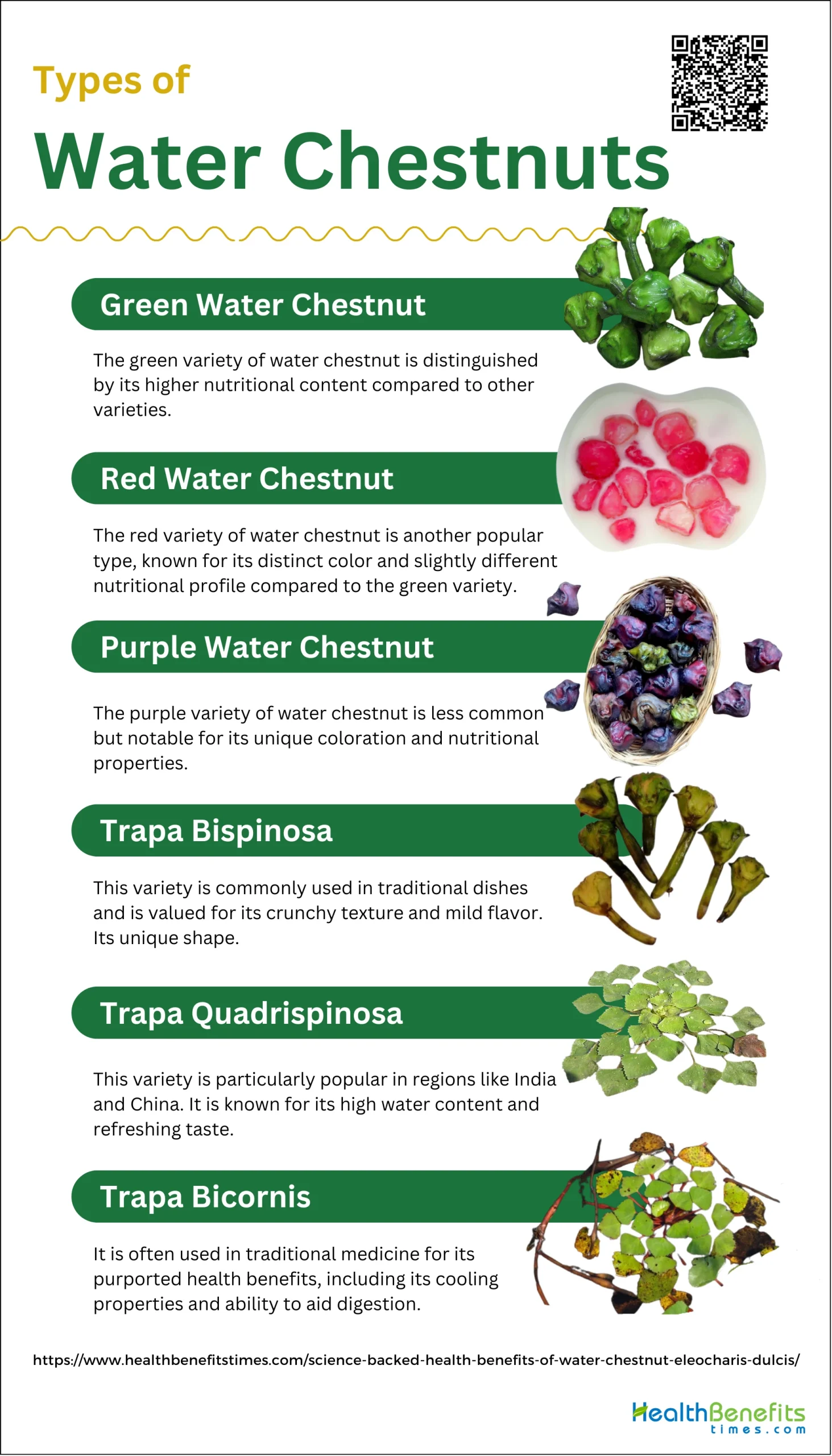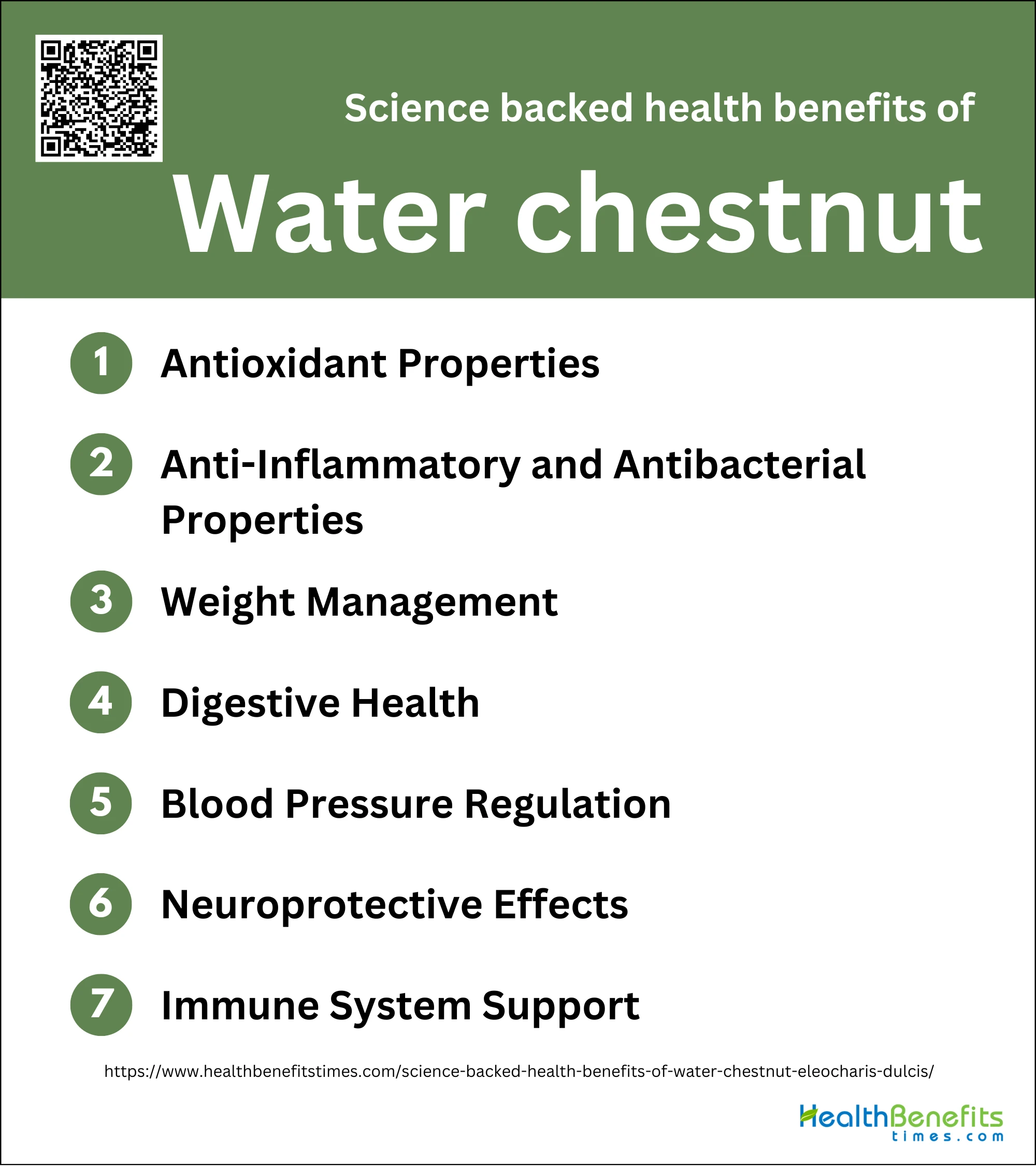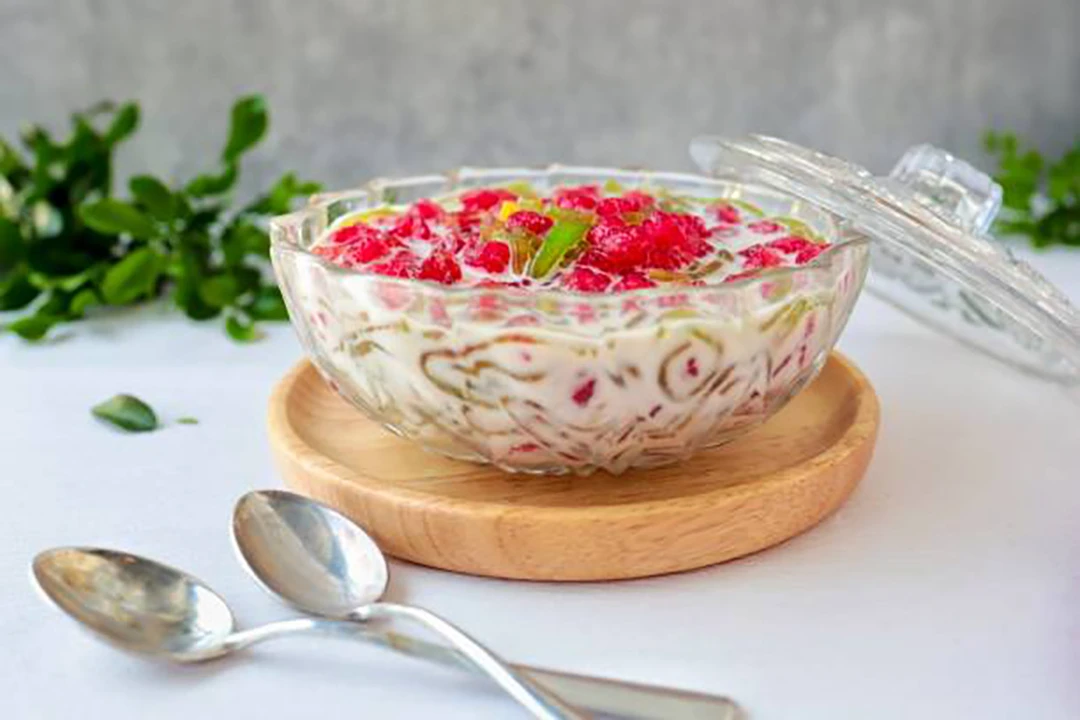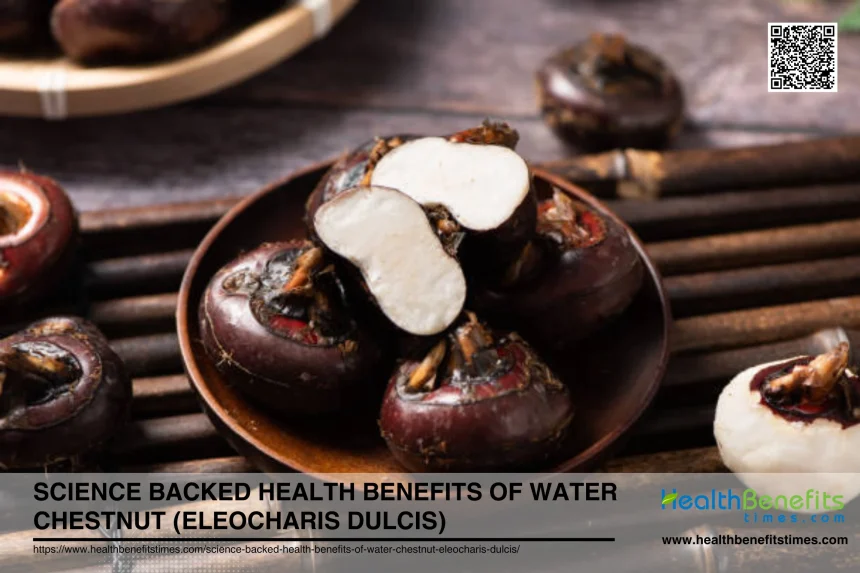Water chestnuts (Eleocharis dulcis), despite their name, are not nuts but rather aquatic vegetables known for their crisp texture and subtle sweetness. These tuberous plants thrive in marshes, ponds, and shallow lakes, primarily in Southeast Asia. Packed with nutrients, water chestnuts are a powerhouse of dietary fiber, potassium, manganese, copper, and various antioxidants like ferulic acid and catechin gallate. Their high water content and low-calorie profile make them an excellent addition to a balanced diet. Scientific research has highlighted numerous health benefits, including improved digestion, enhanced heart health, and potential anti-cancer properties. This article delves into the science-backed health benefits of water chestnuts, exploring why they should be a staple in your diet.
What is Water chestnut ?
Water chestnut is an aquatic plant widely consumed in Oriental cuisine for its sweet, crisp taste and rich nutritional value. The corm of E. dulcis is composed of three main tissues: epidermis, subepidermis, and parenchyma, each with distinct cell wall compositions, including varying levels of sugars, phenolics, and lignin. This plant is not only valued for its culinary uses but also for its potential applications in the food industry, particularly due to its starch, which can be chemically modified to enhance properties such as swelling power, solubility, and paste clarity. Additionally, E. dulcis has been studied for its role in biocontrol, serving as a trap plant for managing pests like the rice white stem borer. The plant is also notable for its resilience, as it can grow in highly acidic swamps and has been associated with aluminum-tolerant bacteria. Furthermore, E. dulcis is susceptible to diseases such as Fusarium wilt, which can significantly impact its cultivation. Overall, E. dulcis is a versatile plant with significant agricultural, ecological, and industrial importance.
Nutritional Profile
Water chestnuts are known for their unique nutritional profile, offering a range of beneficial nutrients while being relatively low in calories. They are primarily composed of water and carbohydrates, with small amounts of protein and fat. Water chestnuts are also a good source of dietary fiber, which aids in digestion and promotes feelings of fullness. Their crisp texture and mild, slightly sweet flavor make them a popular addition to many dishes, while their nutritional composition contributes to their reputation as a healthy food choice.
Macronutrients: Carbs, Protein, and Fat
Water chestnuts are predominantly composed of carbohydrates, which constitute the majority of their caloric content. These carbohydrates are mainly in the form of complex carbs and fiber, contributing to their low glycemic index. The protein content in water chestnuts is relatively low, making them not a significant source of this macronutrient. Similarly, water chestnuts contain very little fat, which contributes to their low calorie count. This macronutrient profile makes water chestnuts a suitable option for those looking to manage their carbohydrate intake while keeping fat and protein consumption low.
Micronutrients: Vitamins and Minerals
Water chestnuts contain a variety of essential micronutrients, although in moderate amounts. They are a good source of potassium, which is important for heart health and proper muscle function. Water chestnuts also provide small amounts of other minerals such as manganese and copper. In terms of vitamins, they contain vitamin B6, which plays a role in brain development and function, as well as small amounts of vitamin C, an important antioxidant. While not exceptionally high in any particular micronutrient, the combination of these vitamins and minerals contributes to the overall nutritional value of water chestnuts.
Caloric Content
Water chestnuts are known for their low caloric content, making them a popular choice for those managing their calorie intake. The exact calorie count can vary slightly depending on preparation methods, but generally, water chestnuts are considered a low-calorie food. This low caloric density, combined with their high water and fiber content, makes them a filling food option that can be incorporated into weight management diets. The low calorie content of water chestnuts allows for their generous use in various dishes without significantly increasing the overall calorie count of meals.
Types of Water Chestnuts
Dive into the fascinating world of water chestnuts, where variety isn’t just the spice of life—it’s a nutritional powerhouse! These aquatic vegetables, known for their crisp texture and subtle sweetness, come in an array of types that might surprise even the most adventurous food enthusiasts. From the nutrient-packed green variety to the antioxidant-rich purple ones, each type of water chestnut brings its own unique flavor profile and health benefits to the table. Whether you’re a culinary explorer or a health-conscious eater, understanding the different varieties of water chestnuts can open up a whole new realm of delicious possibilities in your kitchen. Let’s crunch into the details of these versatile veggies and discover how each variety can add a refreshing twist to your meals!

1. Green Water Chestnut
The green variety of water chestnut is distinguished by its higher nutritional content compared to other varieties. It boasts significantly higher levels of protein, dietary fiber, and essential vitamins such as vitamin C, B6, A, and β-carotene. The green water chestnut also has a higher moisture content, making it particularly refreshing and hydrating. Its rich mineral composition, including abundant potassium, makes it a valuable addition to a balanced diet. The green variety’s superior nutritional profile contributes to its popularity in various culinary applications and health-focused diets.
2. Red Water Chestnut
The red variety of water chestnut is another popular type, known for its distinct color and slightly different nutritional profile compared to the green variety. While it contains lower levels of protein, fiber, and certain vitamins, it still provides a good source of essential nutrients. The red water chestnut is particularly noted for its high carbohydrate content, making it a good energy source. Its unique color and texture make it a versatile ingredient in both traditional and modern dishes. Despite its lower nutrient density compared to the green variety, the red water chestnut remains a valuable food source with its own set of health benefits.
3. Purple Water Chestnut
The purple variety of water chestnut is less common but notable for its unique coloration and nutritional properties. This variety is often found in specific regions such as West Bengal, India. The purple water chestnut is rich in antioxidants, which are responsible for its distinctive color and contribute to its potential health benefits. These antioxidants help combat oxidative stress and may reduce the risk of chronic diseases. The purple variety also contains a good balance of carbohydrates, fiber, and essential minerals, making it a nutritious addition to various dishes. Its unique appearance and health benefits make it an intriguing option for those looking to diversify their diet.
4. Trapa Bispinosa
Trapa bispinosa is another variety of water chestnut that is widely cultivated and consumed, particularly in Asia. This variety is known for its distinctive two-spined fruit, which sets it apart from other types. Trapa bispinosa is rich in carbohydrates and provides a good source of energy. It also contains essential minerals and vitamins, contributing to its nutritional value. This variety is commonly used in traditional dishes and is valued for its crunchy texture and mild flavor. Its unique shape and nutritional benefits make Trapa bispinosa a popular choice in many culinary traditions.
5. Trapa Quadrispinosa
Trapa quadrispinosa is characterized by its four-spined fruit, which gives it a distinctive appearance. This variety is particularly popular in regions like India and China. It is known for its high water content and refreshing taste. Trapa quadrispinosa provides a good source of dietary fiber, which aids in digestion and promotes gut health. It also contains a range of vitamins and minerals, making it a nutritious addition to the diet. The unique shape and texture of Trapa quadrispinosa make it a versatile ingredient in various culinary applications, from salads to cooked dishes.
6. Trapa Bicornis
Trapa bicornis, also known as the horned water chestnut, is another notable variety. This type is recognized by its horn-like projections and is commonly found in Asian countries. Trapa bicornis is valued for its high nutritional content, including carbohydrates, fiber, and essential vitamins and minerals. It is often used in traditional medicine for its purported health benefits, including its cooling properties and ability to aid digestion. The unique appearance and health benefits of Trapa bicornis make it a popular choice in both culinary and medicinal applications.
Science backed health benefits of Water chestnut
Dive into the refreshing world of water chestnuts, the crisp and versatile aquatic tubers that are making waves in the health food scene. While often overlooked, these humble vegetables pack a powerful nutritional punch that’s backed by science. From boosting your immune system to supporting weight management, water chestnuts offer a treasure trove of health benefits that might surprise you. Let’s explore the remarkable ways this low-calorie, nutrient-dense food can enhance your well-being and add a delightful crunch to your meals. Get ready to discover why water chestnuts deserve a prime spot in your diet and how they can contribute to your overall health and vitality.

1. Antioxidant Properties
Water chestnuts contain several antioxidants, including flavonoids and phenolic compounds. These antioxidants help neutralize harmful free radicals in the body, reducing oxidative stress and lowering the risk of chronic diseases such as cancer and heart disease.
2. Anti-Inflammatory and Antibacterial Properties
The bioactive compounds in water chestnuts exhibit anti-inflammatory and antibacterial properties. These properties can help in reducing inflammation and fighting bacterial infections, contributing to overall health and wellness.
3. Weight Management

Due to their high fiber content and low-calorie profile, water chestnuts can be a beneficial addition to a weight management diet. The fiber helps in promoting a feeling of fullness, which can reduce overall calorie intake.
4. Digestive Health
The high fiber content in water chestnuts aids in promoting healthy digestion. It helps in the smooth movement of food through the digestive tract, preventing issues like constipation and promoting regular bowel movements.
5. Blood Pressure Regulation
Water chestnuts are rich in potassium, a mineral that plays a crucial role in regulating blood pressure. Potassium helps balance sodium levels in the body, which can reduce hypertension and lower the risk of stroke and heart disease.
6. Neuroprotective Effects
Some studies suggest that water chestnuts may have neuroprotective effects due to their antioxidant properties. These effects can help in protecting the brain from oxidative damage and may reduce the risk of neurodegenerative diseases.
7. Immune System Support

The vitamins and minerals in water chestnuts, particularly vitamin B6 and manganese, support the immune system. These nutrients help in the production of antibodies and the functioning of immune cells, enhancing the body’s ability to fight infections.
Potential Medicinal Uses
Water chestnuts have been recognized for their potential medicinal uses due to their rich phytochemical composition. They contain antioxidants, flavonoids, and phenolic compounds that can help reduce oxidative stress and inflammation in the body. These properties make water chestnuts a valuable addition to diets aimed at preventing chronic diseases such as heart disease and cancer. Additionally, their high fiber content aids in digestion and helps maintain healthy blood sugar levels, making them beneficial for managing diabetes and other metabolic disorders.
Traditional Medicine Uses
In traditional medicine, water chestnuts have been used for centuries to treat a variety of ailments. They are known for their cooling properties and are often used to alleviate heat-related conditions such as fever and inflammation. Water chestnuts are also used to promote digestion, improve appetite, and treat urinary tract infections due to their diuretic properties. In some cultures, they are believed to have aphrodisiac effects and are used to boost energy and vitality.
Historical Use in Traditional Chinese Medicine
In Traditional Chinese Medicine (TCM), water chestnuts have been utilized for their cooling and detoxifying effects. They are commonly used to clear heat and expel phlegm, making them effective in treating respiratory conditions such as coughs and bronchitis. Water chestnuts are also used to promote urination and relieve symptoms of jaundice. Their ability to balance the body’s internal heat makes them a popular remedy for various inflammatory conditions.
Modern Applications and Studies
Modern studies have explored the various health benefits of water chestnuts, confirming many of their traditional uses. Research has shown that water chestnuts possess significant antioxidant and anti-inflammatory properties, which can help in preventing and managing chronic diseases. Additionally, water chestnut flour is being incorporated into various food products to enhance their nutritional profile. Studies have also indicated that water chestnuts can improve blood pressure regulation and support weight management due to their high fiber and low-calorie content.
How to Incorporate Water Chestnuts into Your Diet
Water chestnuts are versatile aquatic vegetables that can be easily incorporated into various dishes to enhance both nutrition and texture. They can be added to stir-fries, salads, soups, and even smoothies. Their mild, slightly sweet flavor makes them an excellent addition to both savory and sweet recipes. For a quick and healthy snack, try slicing water chestnuts and eating them with a light dip. They can also be used as a low-calorie substitute for croutons in salads or as a crunchy topping for casseroles.

Raw
Water chestnuts can be enjoyed raw, offering a crisp and refreshing texture to various dishes. To eat them raw, simply peel off the brown skin and slice or dice the white flesh. They make an excellent addition to fresh salads, providing a satisfying crunch and subtle sweetness. Raw water chestnuts can also be used as a healthy dipper for hummus or guacamole. Consuming water chestnuts raw preserves their full nutritional profile, including their high water content, fiber, and essential vitamins and minerals.
Simple Ways to Eat Them Raw
There are several simple ways to incorporate raw water chestnuts into your diet. Slice them thinly and add them to green salads or coleslaw for extra crunch. Dice them and mix them into fresh salsa or guacamole for a unique twist. You can also enjoy them as a standalone snack, perhaps with a sprinkle of sea salt or a squeeze of lemon juice. For a refreshing summer treat, try adding sliced raw water chestnuts to fruit salads or using them as a garnish for cold soups.
Benefits of Consuming Raw
Consuming water chestnuts raw offers several benefits. Raw water chestnuts retain their full nutritional value, including their high content of antioxidants, fiber, and essential minerals. The crisp texture of raw water chestnuts can help stimulate saliva production, aiding in digestion. Additionally, the high water content in raw water chestnuts can contribute to hydration. Raw consumption also preserves the natural enzymes present in water chestnuts, which may have potential health benefits.
Cooked
Cooking water chestnuts opens up a world of culinary possibilities. They are commonly used in Asian cuisine, particularly in stir-fries, where they maintain their crunchiness even after cooking. Water chestnuts can be boiled, steamed, or sautéed, and they absorb flavors well, making them an excellent addition to various dishes. They can be used in stuffings, added to soups and stews, or even incorporated into baked goods for added texture.
Popular Recipes and Dishes
Water chestnuts feature prominently in many popular recipes. In Chinese cuisine, they are often used in stir-fries like chop suey or mixed vegetable dishes. They are also a key ingredient in many dumpling fillings. In Western cuisine, bacon-wrapped water chestnuts are a popular appetizer. Water chestnuts can be added to chicken or tuna salads for extra crunch, or used in vegetable medleys as a side dish. They also work well in casseroles and can be pureed to add creaminess to soups without the need for dairy.
Nutritional Changes When Cooked
Cooking water chestnuts can lead to some changes in their nutritional profile. While some water-soluble vitamins may be lost during the cooking process, many of the minerals and fiber remain intact. Cooking can actually increase the bioavailability of certain nutrients, making them easier for the body to absorb. However, overcooking should be avoided as it can lead to a loss of texture and further nutrient degradation. Generally, light cooking methods like quick stir-frying or steaming are preferable to preserve both nutrients and texture.
Juices and Smoothies
Water chestnuts can be an interesting addition to juices and smoothies, providing a unique flavor and nutritional boost. While not commonly used in liquid form, they can be blended into smoothies for added fiber and nutrients. Their mild flavor allows them to blend well with various fruits and vegetables without overpowering other ingredients. When juiced or blended, water chestnuts can contribute to the overall hydration and nutrient content of the beverage.
Combinations with Other Fruits and Vegetables
Water chestnuts can be combined with a variety of fruits and vegetables in smoothies and juices. They pair well with tropical fruits like pineapple and mango, adding a refreshing crunch to fruit-based smoothies. For a green smoothie, try blending water chestnuts with spinach, apple, and cucumber. They can also be combined with berries for an antioxidant-rich drink. In vegetable juices, water chestnuts can be juiced alongside carrots, celery, and ginger for a nutritious and refreshing beverage.
Benefits of Liquid Consumption
Consuming water chestnuts in liquid form, such as in juices or smoothies, offers several benefits. It allows for easy digestion and quick absorption of nutrients. The high water content of water chestnuts contributes to overall hydration when consumed in liquid form. Blending water chestnuts into smoothies can help increase fiber intake, which is beneficial for digestive health. Additionally, combining water chestnuts with other fruits and vegetables in smoothies or juices can create a nutrient-dense beverage that provides a wide range of vitamins, minerals, and antioxidants.
Precautions and Potential Side Effects
While water chestnuts are generally considered safe for consumption, it’s important to be aware of potential precautions and side effects. As with any food, some individuals may experience allergic reactions. Additionally, while water chestnuts are nutritious, overconsumption could potentially lead to digestive discomfort due to their high fiber content. It’s always advisable to introduce new foods gradually into your diet and observe any bodily reactions.
Possible Allergic Reactions
Although allergies to water chestnuts are relatively rare, they can occur. Symptoms of an allergic reaction may include itching or swelling of the mouth, throat, or skin, difficulty breathing, or digestive issues. In severe cases, anaphylaxis may occur, which is a life-threatening emergency. If you have known allergies to other nuts or aquatic plants, it’s advisable to exercise caution when consuming water chestnuts for the first time. If you experience any allergic symptoms after eating water chestnuts, discontinue use and consult a healthcare professional immediately.
Overconsumption Concerns
While water chestnuts are nutritious and generally safe to consume, overconsumption may lead to some digestive discomfort. Their high fiber content, while beneficial for digestive health in moderate amounts, could potentially cause bloating, gas, or abdominal discomfort if consumed in excess. As with any food, it’s important to consume water chestnuts as part of a balanced diet and in moderation. If you’re not accustomed to high-fiber foods, it’s advisable to introduce water chestnuts gradually into your diet to allow your digestive system to adjust.
Interaction with Medications
Based on the available information, there is currently no specific data regarding interactions between water chestnuts and medications. However, this doesn’t necessarily mean that no interactions exist. As water chestnuts contain various compounds and nutrients, it’s always prudent to consult with a healthcare provider or pharmacist if you’re taking medications and plan to significantly increase your intake of water chestnuts or any other food. They can provide personalized advice based on your specific health conditions and medication regimen.
Conclusion
Water chestnuts are a remarkable aquatic plant that not only enhances culinary dishes with their crisp texture and mild sweetness but also offers a wealth of health benefits. Rich in antioxidants, fiber, and essential nutrients, they support digestive health, weight management, and blood pressure regulation while also exhibiting anti-inflammatory and antibacterial properties. Their versatility allows for easy incorporation into various diets, whether consumed raw, cooked, or blended into smoothies. Despite being low in calories, water chestnuts provide significant nutritional value, making them an excellent addition to a balanced diet. Overall, their unique qualities and potential health benefits underscore the importance of including water chestnuts in everyday meals for improved well-being.
ADDITIONAL RESOURCES
Here is a list of US organizations related to research on herbs and spices, along with their short descriptions and URLs:
1. American Botanical Council (ABC)
The American Botanical Council is dedicated to providing accurate and reliable information on the uses of herbs and medicinal plants. They support research and education on herbal medicine.
2. Herb Research Foundation (HRF)
HRF focuses on educating the public, healthcare professionals, and industry about the safe and effective use of herbs. They conduct and support research on the health benefits of herbs.
3. National Center for Complementary and Integrative Health (NCCIH)
Part of the National Institutes of Health (NIH), NCCIH conducts and supports research and provides information about complementary health products and practices, including herbs and spices.
4. American Herbal Pharmacopoeia (AHP)
AHP develops standards of identity, purity, quality, and testing for botanical ingredients to ensure they are accurately identified and meet appropriate standards.
5. American Herbal Products Association (AHPA)
AHPA is a national trade association and voice of the herbal products industry. They promote the responsible commerce of herbal products and conduct research to support their safe use.
6. Integrative Medicine & Health Research Program at Mayo Clinic
This program conducts research on the use of herbal supplements and other integrative therapies to improve health and treat diseases.
Bastyr University is a leader in natural health arts and sciences. They conduct research on herbal medicine, providing evidence-based insights into the therapeutic use of herbs and spices.
Recommendations for books on Water Chestnut
Here are some recommended books on research related to Water Chestnut (Trapa natans) along with their links:
1. “Handbook of Herbs and Spices, Volume 3“ by K.V. Peter
This book covers various herbs and spices, including water chestnuts, providing detailed information on their cultivation, uses, and health benefits.
2. “The Complete Book of Fruits and Vegetables“ by Francesco Bianchini and Francesco Corbetta
This book offers comprehensive information on a variety of fruits and vegetables, including water chestnuts, with insights into their history, cultivation, and nutritional benefits.
3. “Vegetables of the World“ by James Wong
An extensive guide to vegetables from around the globe, this book includes a section on water chestnuts, detailing their cultivation, culinary uses, and health benefits.
4. “The New Oxford Book of Food Plants“ by John Vaughan and Catherine Geissler
This reference book provides detailed descriptions and illustrations of various food plants, including water chestnuts, focusing on their botanical aspects and uses.
5. “Edible Wild Plants: Wild Foods from Dirt to Plate“ by John Kallas
This book explores wild edible plants, including water chestnuts, providing practical information on identification, harvesting, and preparation.
FAQS
- What are the nutritional components of water chestnuts?
Water chestnuts are highly nutritious and low in calories. A 100-gram serving contains approximately 97 calories, 0.1 grams of fat, 23.9 grams of carbohydrates, 3 grams of fiber, and 2 grams of protein. They are also rich in potassium, manganese, copper, vitamin B6, and riboflavin.
- How do water chestnuts benefit heart health?
Water chestnuts are beneficial for heart health primarily due to their high potassium content, which helps lower blood pressure. Studies have shown that increased potassium intake is associated with a reduced risk of stroke and heart disease.
- Can water chestnuts help with weight loss?
Yes, water chestnuts can aid in weight loss. They are low in calories and high in fiber, which helps promote a feeling of fullness and reduces overall calorie intake. This makes them an excellent addition to a weight loss diet.
- What antioxidants are found in water chestnuts, and what are their benefits?
Water chestnuts are rich in antioxidants such as ferulic acid, gallocatechin gallate, epicatechin gallate, and catechin gallate. These antioxidants help combat oxidative stress, reducing the risk of chronic diseases like heart disease, type 2 diabetes, and certain cancers.
- How do water chestnuts support digestive health?
Water chestnuts are high in dietary fiber, which aids in digestion by promoting regular bowel movements and preventing constipation. Fiber also helps maintain a healthy gut by supporting beneficial bacteria.
- Are water chestnuts beneficial for managing diabetes?
Yes, water chestnuts can be beneficial for managing diabetes. Their high fiber content helps slow the absorption of sugar in the bloodstream, preventing sudden spikes in blood sugar levels. This makes them a good option for people with diabetes.
- Can water chestnuts improve skin health?
Water chestnuts have anti-inflammatory properties that can help reduce skin inflammation and promote healing. The antioxidants in water chestnuts also help protect the skin from oxidative damage.
- What are the potential side effects of consuming water chestnuts?
While water chestnuts are generally safe to eat, excessive consumption can lead to digestive issues such as gas, bloating, and diarrhea. Allergic reactions are rare but possible, and individuals with severe shellfish allergies should be cautious due to the risk of cross-contamination.
- How can water chestnuts be incorporated into a diet?
Water chestnuts can be eaten raw, boiled, grilled, pickled, or canned. They are commonly used in stir-fries, salads, soups, and as a crunchy topping for various dishes. They can also be used in desserts and baked goods.
- Do water chestnuts have any unique properties that make them stand out in cooking?
Yes, water chestnuts remain crisp even after cooking due to their ferulic acid content. This unique property makes them a popular ingredient in many Asian dishes, adding a crunchy texture to stir-fries, soups, and salads.







